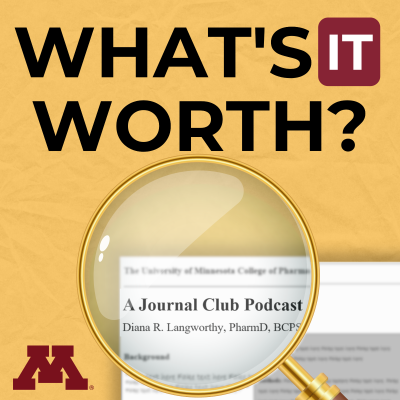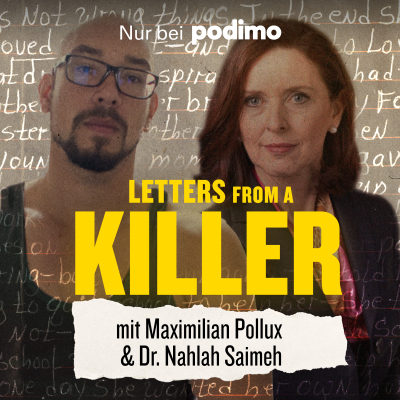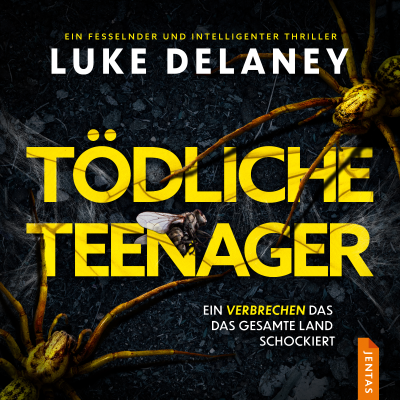
What's it Worth? A Journal Club Podcast
Englisch
Gratis en Podimo
Kostenlos hören bei Podimo
Starte jetzt und verbinde dich mit deinen Lieblingspodcaster*innen
- Vertraut von über 1 Mio. deutschen Hörer*innen
- Über 1.000 lokale Podcasts und Shows – nur bei Podimo
- Keine Zahlung nötig
Mehr What's it Worth? A Journal Club Podcast
Get into the weeds with us as we take deep dives into clinical trials and build the essential skills of evidence critique! This podcast is a tool for healthcare professions students and practitioners to sharpen their science sleuth skills, learn key concepts about study design, biostatistics, and application of evidence to clinical practice.
Alle Folgen
27 FolgenS3E10 | GLP-1 Medications and Migraine - Exploring the Pressure Hypothesis
🧠 Episode Summary Could a medication designed for weight loss change how we think about migraine prevention? In this episode, host Diana Langworthy sits down with returning guest Dr. Natalie Heinrich, PharmD and student contributor Nena Abosi, PharmD Candidate 2026 to unpack a 2025 Headache pilot study evaluating liraglutide as an add-on therapy for adults with obesity and high-frequency or chronic migraine. The team breaks down study design, results, and limitations while questioning whether the observed benefit stems from weight loss, intracranial-pressure changes, or something else entirely. 💬 Key Takeaways * Study Design: Prospective open-label pilot (n = 31) using liraglutide 1.2 mg daily × 12 weeks in adults with BMI > 30 kg/m² and ≥ 8 headache days/month unresponsive to ≥ preventives. * Results: Headache days decreased by ~9 per month (≈ 50 % reduction); disability scores improved significantly, but BMI change was minimal. * Mechanism: Benefit appeared independent of weight loss—raising curiosity about GLP-1 effects on intracranial pressure and CGRP release. * Tolerability: Mild GI symptoms (~40 %), no discontinuations. * Caveats: Small sample, no control group, single center — results are hypothesis-generating, not practice-changing. * Clinical Pearl: Pilot studies like this spark conversation and awareness for emerging mechanisms while reminding clinicians to stay evidence-curious. 🧩 Featured Study * Braca S, Russo CV, Stornaiuolo A, et al. Effectiveness and tolerability of liraglutide as add-on treatment in patients with obesity and high-frequency or chronic migraine: A prospective pilot study. Headache. 2025; 00: 1–8. doi:10.1111/head.14991 [https://doi.org/10.1111/head.14991] 🎙️ Guests * Natalie Heinrich, PharmD, BCPS – Clinical Pharmacist in Neurology, M Health Fairview * Nena Abosi, PharmD Candidate (2026) – University of Minnesota College of Pharmacy 🎙️ Host * Diana Langworthy, PharmD, BCPS – Associate Professor, University of Minnesota College of Pharmacy 💬 Join the Conversation Have a study you'd like us to decode on a future episode? Send it our way at whatsitworthpodcast@gmail.com. We'd also love to hear your thoughts—drop a comment, share your takeaways, or let us know how you're using this evidence in practice.
S3E9 | Glucose-Lowering Drugs and COPD Exacerbations — Dual Benefits of SGLT2 and GLP-1 Therapy?
New population-based study suggests SGLT2 inhibitors and GLP-1 receptor agonists may reduce COPD exacerbations in patients with type 2 diabetes. In this episode of What's It Worth?, we examine a large real-world study assessing whether glucose-lowering medications influence the risk of COPD exacerbations in patients with type 2 diabetes and chronic obstructive pulmonary disease. We focus on SGLT2 inhibitors and GLP-1 receptor agonists and discuss whether potential pulmonary benefits should influence drug selection in patients with both conditions. Guest: Ashley Wilke, PharmD — PGY2 Critical Care Pharmacy Resident at M Health Fairview East Bank Hospital. Study at a Glance * Design: Retrospective cohort study using nationwide claims and registry data * Population: Adults with type 2 diabetes and COPD initiating glucose-lowering therapy * Exposures: SGLT2 inhibitors, GLP-1 receptor agonists, DPP-4 inhibitors * Primary outcome: COPD exacerbations requiring hospitalization or systemic steroids * Key Finding: SGLT2 inhibitors and GLP-1 receptor agonists were associated with a lower risk of COPD exacerbations compared with DPP-4's * KEY Caveats: Results are observational and this study cannot prove causality - only association. * Tune in for our conclusions when we ask, "What's it Worth?"! Key teaching points 1. SGLT2 inhibitors and GLP-1 RAs may reduce pulmonary inflammation and fluid overload, potentially contributing to fewer exacerbations. 2. In a patient with both COPD and type 2 diabetes, these agents may offer meaningful extra-glycemic benefits. 3. This evidence supports shared decision-making, not mandatory therapy selection 4. Pharmacists can identify dual-benefit opportunities and tailor therapy based on comorbidities, cardiovascular risk, and exacerbation history. Citation: Patorno E, Feldman HA, Bykov K, et al. Glucose-lowering medications and risk of chronic obstructive pulmonary disease exacerbations in type 2 diabetes. JAMA Intern Med. 2025;185(4):405-414. doi:10.1001/jamainternmed.2024.7811 🎧 If you find this episode helpful, follow and leave a quick rating—it helps other clinicians and learners find high-quality, evidence-based content. 🎧 Email me at whatsitworthpodcast@gmail.com [whatsitworthpodcast@gmail.com] if you have an article suggestion for me to decode!
S3E8 | SABATO Trial - Oral vs IV Antibiotics for Uncomplicated MSSA Bacteremia
Can stable patients with uncomplicated Staphylococcus aureus bacteremia finish therapy by mouth? The SABATO trial tested early oral switch versus full-course IV therapy. In this episode, we decode the SABATO trial - a randomized, open-label, non-inferiority study that compared continued intravenous (IV) antibiotics with an early oral switch in low-risk Staphylococcus aureus bacteremia (SAB). Guest: Dr. Jen Ross, PharmD, BCIDP — Clinical Infectious Diseases Pharmacist at M Health Fairview Study at a glance * Design: Multicenter, randomized, open-label, non-inferiority trial * Population: 213 adults with uncomplicated S. aureus bacteremia after > 5-7 days of IV therapy and no signs of complicated infection * Intervention: Early oral switch (e.g., TMP-SMX, clindamycin, linezolid) * Comparator: Continued full-course IV therapy * Primary endpoint: SAB-related complications within 90 days * Results: Primary outcome occurred in 13% of patients in oral group vs 12% in IV group which met non-inferiority criteria * KEY Caveats: Did not include patients with IV drug use; stopped study early which can skew towards a significant finding; changed NI margin midway through which leads to accepting a wider risk of difference. * Tune in to hear our perspectives on what this study is worth!? Citation: Kaasch AJ et al. Early Oral Switch vs Continued IV Therapy for Low-Risk Staphylococcus aureus Bacteremia (SABATO Trial). Lancet Infect Dis. 2024; 24(3): 310-320. DOI 10.1016/S1473-3099(24)00032-X. 🎧 If you find this breakdown helpful, follow and leave a quick rating—it helps other clinicians and learners find high-quality, evidence-based content. 🎧 Email me at whatsitworthpodcast@gmail.com [whatsitworthpodcast@gmail.com] if you have an article suggestion for me to decode!
S3E7 | Aluminum-Adsorbed Vaccines and Chronic Disease Risk in Children — Danish Nationwide Cohort (Annals 2025)
Large Danish study finds no link between aluminum-containing childhood vaccines and chronic diseases — including autism and ADD/ADHD. In this episode, we unpack the 2025 Annals of Internal Medicine study evaluating whether early-life exposure to aluminum-adsorbed vaccines is associated with autoimmune, allergic, or neurodevelopmental outcomes such as autism spectrum disorder or ADHD. We review the data behind the headlines, explain the study design and data source, and discuss how clinicians can communicate this evidence to parents. Guest: Dr. Ann Philbrick, PharmD, FCCP, BCACP — Professor of Pharmaceutical Care & Health Systems at the University of Minnesota College of Pharmacy, with expertise in vaccine/immunization delivery and ambulatory care. Study at a glance - Design Nationwide Danish cohort, 1.2 million children (1997–2020) - Exposure Total aluminum (mg) from vaccines in first 2 years of life -Outcomes 50 chronic conditions (autoimmune, allergic, neurodevelopmental) - Results No increased risk; aHR 0.98 for autoimmune, 0.99 for atopic/allergic, 0.93 for neurodevelopmental disorders - Takeaway Findings were incompatible with moderate or large increases in risk and reinforce vaccine safety. Key teaching points 1. Policy-driven changes in Danish vaccine formulations allowed a natural quasi-experiment design. 2. Large registry-based cohorts can rule out moderate safety signals. 3. Epidemiologic evidence does not support prior theoretical aluminum toxicity concerns. Citation: Andersson NW et al. Aluminum-Adsorbed Vaccines and Chronic Diseases in Childhood: A Nationwide Cohort Study. Ann Intern Med. 2025. doi:[10.7326/ANNALS-25-00997](https://doi.org/10.7326/ANNALS-25-00997) 🎧 If you find this breakdown helpful, follow and leave a quick rating—it helps other clinicians and learners find high-quality, evidence-based content. 🎧 Email me at whatsitworthpodcast@gmail.com [whatsitworthpodcast@gmail.com] if you have an article suggestion for me to decode!
S3E6 (#22) Twice is Nice! Lenacapavir vs Daily Emtricitabine/Tenofovir for PrEP
Welcome back to What's it Worth! Join your host, Dr. Diana Langworthy and returning co-host Dr. Meade Avery (2025 U of MN CoP Grad!!) as we PrEPare our clinical conclusions about a novel antiviral for HIV prevention. We also welcome an HIV expert, Dr. Daniel (Jude) Holt, who is a clinical pharmacist at North Memorial Health in the Infectious Diseases clinic. The study we critique compares twice yearly lenacapavir with daily emtricitabine/tenofovir alafenamide (F/TAF) or emtricitabine/tenofovir disoproxil fumarate (F/TDF) in cisgender women for HIV prevention (PrEP). Key Points 1. HIV prevention is a critical step in the fight to end HIV 2. There are many barriers to compliance with daily oral HIV preventative medications including access and compliance 3. Twice yearly lenacapavir has been proven effective at preventing HIV in men who have sex with men and transgender women, but was yet to be studied in cisgender women 4. A twice yearly regimen can help patients overcome barriers to compliance 5. Will we find out "Where's "Wald"-o in our Stat Stop? ------> Tune in to find out! References 1. [EPISODE TRIAL] Bekker LG, Das M, Abdool Karim Q, et al. Twice-Yearly Lenacapavir or Daily F/TAF for HIV Prevention in Cisgender Women. NEJM 2024;391(13):1179-1192. 2. Kelley CF, Acevedo-Quinones M, Agwu AL, et al. Twice yearly lenacapavir for HIV prevention in men and gender-diverse persons. NEJM 2024;392(13):1261-1276. 3. Bekerman E, Hansen D, Lu B, et al. Long-acting capsid inhibitor effective as PrEP against vaginal SHIV transmission in macaques. In: Proceedings and Abstracts of the 11th IAS Conference on HIV Science, July 18–21, 2021. Virtual: International AIDS Society, 2021. abstract. 4. Centers for Disease Control and Prevention. "HIV Prevention Research Synthesis Project." HIV Compendium of Best Practices. October 24, 2024, June 6, 2025, https://www.cdc.gov/hivpartners/php/hiv-treatment/index.htmlnters for Disease Control and Prevention [https://www.cdc.gov/hivpartners/php/compendium/index.html] Contact Information Podcast email: whatsitworthpodcast@gmail.com [whatsitworthpodcast@gmail.com] Expert Guest Dr. Daniel (Jude) Holt, PharmD, AAHIVP, CSP Clinical Pharmacy Specialist - Infectious Disease Specialty Pharmacy Infectious Disease Support Daniel.Holt@northmemorial.com Host Information Dr. Diana R. Langworthy, PharmD, BCPS Clinical Associate Professor, University of Minnesota College of Pharmacy Clinical Pharmacist - Inpatient Internal Medicine, M Health Fairview East Bank Hospital Co-Host Information Meade Avery, PharmD 2025 Graduate, University of Minnesota College of Pharmacy















































